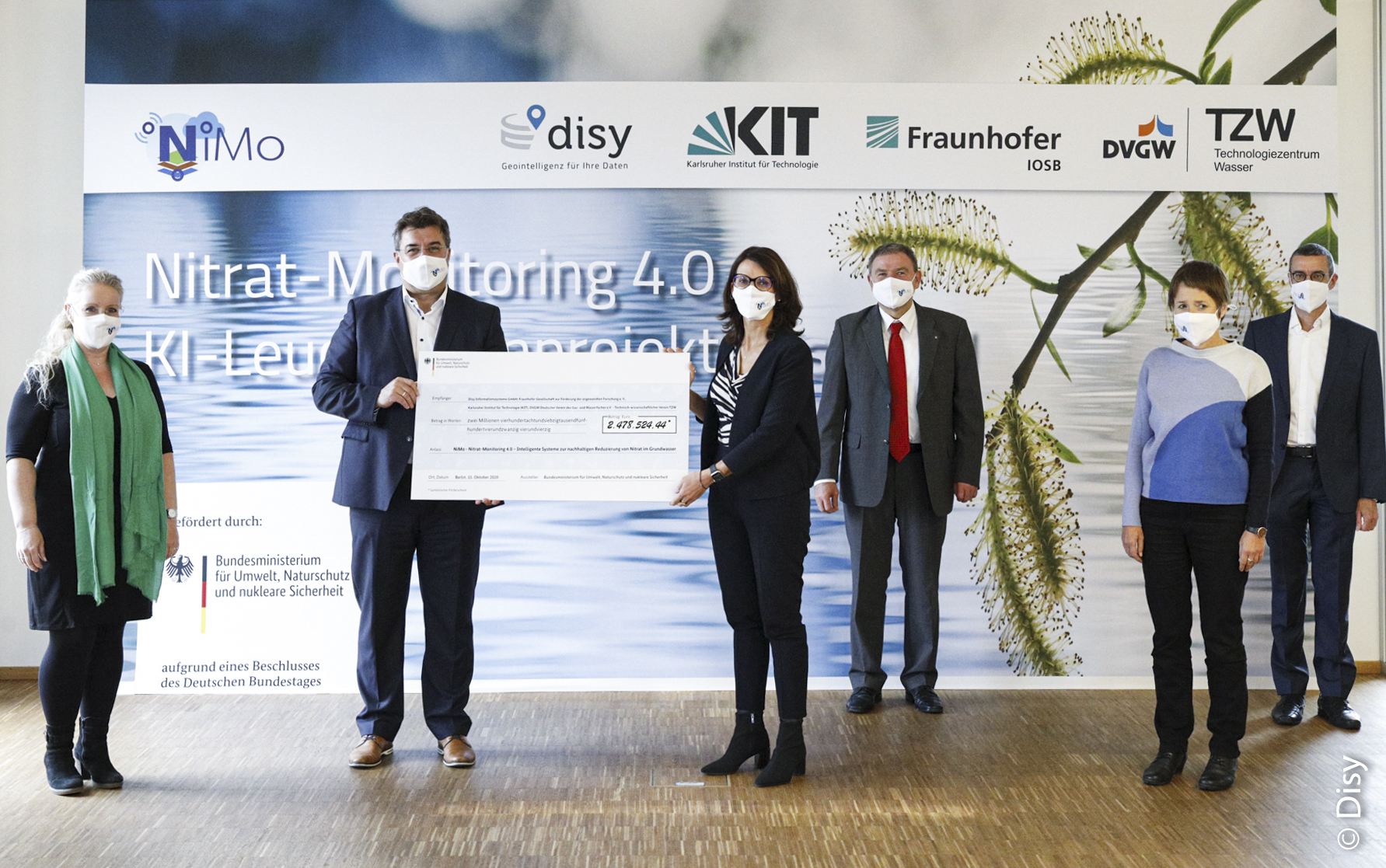Artificial intelligence for groundwater protection
Karlsruhe, 16 October 2020
Using a model for predictions, a group of researchers from Karlsruhe intends to reduce nitrate in groundwater efficiently and sustainably. Artificial intelligence (AI) will be used for this purpose. The aim is to achieve intelligent decision support, in which computers can learn independently - in order to take appropriate measures. As part of its AI strategy, the Federal Environment Ministry (BMU) is funding projects that use artificial intelligence to overcome ecological challenges (AI lighthouses). Parliamentary State Secretary Rita Schwarzelühr-Sutter has now handed over the notice of funding.
In recent years, high nitrate concentrations in groundwater and their consequences for humans and the environment have become increasingly well known to the public. If the crops grown in the fields are not fertilized in accordance with plant requirements, more nitrogen enters the soil than the plants can absorb. As a result, the nitrogen dissolved in water seeps into the groundwater as nitrate. About 70 % of Germany's drinking water is obtained from groundwater. Too high nitrate levels in drinking water can lead to health problems, so that the utilities have to take extensive measures to reduce nitrate levels. Water quality monitoring shows that the condition of groundwater is endangered in many places.
AI Lighthouse Project Nitrate Monitoring 4.0 is funded by the BMU
In the joint project "Nitrate Monitoring 4.0 - Intelligent Systems for the Sustainable Reduction of Nitrate in Groundwater (NiMo 4.0)", scientists are developing an intelligent system to better understand and predict the spatial and temporal distribution of nitrate in groundwater with only a few measuring points. With the help of such predictions, which are based on machine learning methods, intelligent decision support is to be achieved in order to find optimal locations for additional measurements and to design groundwater protection programmes in a targeted manner. NiMo 4.0 is one of 28 projects nationwide funded by the Federal Ministry for the Environment, Nature Conservation and Nuclear Safety (BMU) as part of the initiative "AI Lighthouses for the Environment, Climate, Nature and Resources" with a total of 2.478 million euros.
Interdisciplinary consortium develops Nitrate Monitoring 4.0
For this BMU joint project, an interdisciplinary consortium with partners from basic and application-oriented research, technology transfer and industry is pooling its expertise: Disy Informationssysteme GmbH (Disy, project management), a spin-off of the FZI and the University of Karlsruhe, today's Karlsruhe Institute of Technology (KIT), the Department of Hydrogeology of the Institute of Applied Geosciences (AGW) of KIT, the Fraunhofer IOSB with its sites in Karlsruhe and Ilmenau, and the DVGW Technology Center Water (TZW) with its sites in Karlsruhe and Dresden. The developed solution approaches are implemented and demonstrated in two pilot regions of importance to water management: in the catchment areas of the Zweckverband Landeswasserversorgung in Baden-Württemberg and the Wasser- und Abwasser-Zweckverband Niedergrafschaft in Lower Saxony.
The AGW at KIT is a German leader in research on the application of artificial intelligence for hydrogeological problems and has many years of experience in the analysis and assessment of pollutants in groundwater. In the Nitrate Monitoring 4.0 project, the AGW contributes its expertise mainly to the AI-supported modeling of nitrate distribution in groundwater using neural networks. The AGW is also responsible for the overall technical and scientific coordination of the project.
The Fraunhofer IOSB supports the AI-supported data evaluation in the project in particular with a procedure model for the systematic use of machine learning methods as well as a prediction model for the nitrate content in groundwater in order to detect abnormalities in measured values at an early stage. Furthermore, the IOSB has a focus on the design of an intelligent sensor data infrastructure. In particular, the lightweight standard SensorThingsAPI of the Open Geospatial Consortium (OGC), which was co-designed by the IOSB, is to be used and further developed, which facilitates both the connection of new sensors and the integration of existing databases.
The TZW combines research and practice in the form of expertises, studies and examination services for the entire water sector. One focus of its activities is the scientific consulting of water supply companies. Here, resource management and the problem area "groundwater protection and agriculture" play a central role. The TZW has extensive practical experience with groundwater monitoring, with the analysis of large amounts of data and data sets on nitrate pollution in German raw water resources. Via an online portal, which the TZW has developed in cooperation with Disy, water suppliers can provide data on groundwater and raw water quality for regional and supra-regional evaluations. In the NiMo 4.0 project, TZW is working on the topics of optimisation of groundwater monitoring networks and tools for monitoring groundwater quality in daily operations.
Disy Informationssysteme GmbH, which coordinates the joint project, brings together the various scientific and technical contributions in prototype software solutions for intelligent data analysis and user-friendly decision support systems. Development focuses here are efficient data visualizations and effective user interfaces for end users as well as modern data infrastructures that can be well embedded into the existing software landscape of the users. "We are very much looking forward to this challenging project on a topic of great ecological importance," says Disy managing director Claus Hofmann, proud of winning this grant in a highly competitive ideas competition. "NiMo 4.0 will also help Disy to use and further develop state-of-the-art methods of data science and artificial intelligence for environmental protection".

